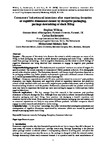Consumers' behavioural intentions after experiencing deception or cognitive disonance caused by deceptive packaging, package downsizing or slack filling
| dc.contributor.author | Wilkins, SJK | en |
| dc.contributor.author | Beckenuyte, C | en |
| dc.contributor.author | Butt, MM | en |
| dc.date.accessioned | 2016-02-28T13:36:28Z | |
| dc.date.available | 2016-02-28T13:36:28Z | |
| dc.date.issued | 2016-02-08 | en |
| dc.identifier.uri | http://hdl.handle.net/10026.1/4367 | |
| dc.description.abstract |
Purpose – The purpose of this study is to discover the extent to which consumers are aware of air filling in food packaging, the extent to which deceptive packaging and slack filling – which often result from package downsizing – lead to cognitive dissonance, and the extent to which feelings of cognitive dissonance and being deceived lead consumers to engage in negative post purchase behaviours. Design/methodology/approach – The study analysed respondents’ reactions to a series of images of a specific product. The sample consisted of consumers of FMCG products in the UK. Five photographs served as the stimulus material. The first picture showed a well-known brand of premium chocolate in its packaging and then four further pictures each showed a plate with a different amount of chocolate on it, which represented different possible levels of package fill. Findings – Consumer expectations of pack fill were positively related to consumers’ post purchase dissonance, and higher dissonance was negatively related to repurchase intentions and positively related to both intended visible and non-visible negative post purchase behaviours, such as switching brand and telling friends to avoid the product. Furthermore, consumers with low product involvement were less likely to repurchase the brand and were more willing to engage in visible and non-visible negative behaviours. Research implications – The key message from this research is that consumer post purchase dissonance is likely to damage the firm. Although firms may initially achieve increased sales through deceptive packaging and slack filling, these practices risk damaging a brand’s reputation and consumer loyalty to the brand. Firms need to strike a balance between packaging size and content, and as consumer expectations are likely to vary across different products, individual companies should engage in market research and substantive market testing. Originality/value – To the authors’ knowledge, this is the first study that investigates antecedents and consequences of cognitive dissonance experienced by consumers which was caused by perceived deceptive packaging and/or slack filling. | en |
| dc.format.extent | 213 - 235 | en |
| dc.language.iso | en | en |
| dc.publisher | Emerald | en |
| dc.subject | Consumer research | en |
| dc.subject | Packaging | en |
| dc.subject | Deception | en |
| dc.subject | Consumer behaviour | en |
| dc.title | Consumers' behavioural intentions after experiencing deception or cognitive disonance caused by deceptive packaging, package downsizing or slack filling | en |
| dc.type | Journal Article | |
| plymouth.issue | 1/2 | en |
| plymouth.volume | 50 | en |
| plymouth.publication-status | Published | en |
| plymouth.journal | European Journal of Marketing | en |
| dc.identifier.doi | 10.1108/EJM-01-2014-0036 | en |
| plymouth.organisational-group | /Plymouth | |
| dcterms.dateAccepted | 2015-06-19 | en |
| dc.rights.embargoperiod | Not known | en |
| rioxxterms.versionofrecord | 10.1108/EJM-01-2014-0036 | en |
| rioxxterms.licenseref.uri | http://www.rioxx.net/licenses/all-rights-reserved | en |
| rioxxterms.licenseref.startdate | 2016-02-08 | en |
| rioxxterms.type | Journal Article/Review | en |


